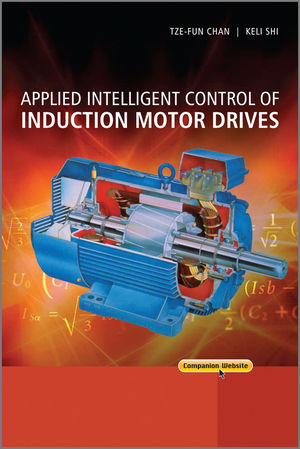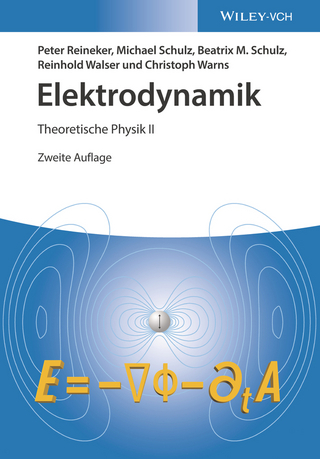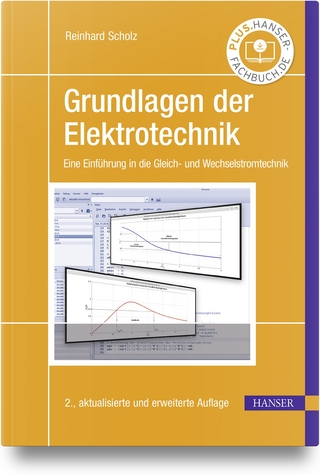
Applied Intelligent Control of Induction Motor Drives
Wiley-IEEE Press (Verlag)
978-0-470-82556-3 (ISBN)
- Lieferbar (Termin unbekannt)
- Versandkostenfrei innerhalb Deutschlands
- Auch auf Rechnung
- Verfügbarkeit in der Filiale vor Ort prüfen
- Artikel merken
Presents major artificial intelligence techniques to induction motor drives
Uses a practical simulation approach to get interested readers started on drive development
Authored by experienced scientists with over 20 years of experience in the field
Provides numerous examples and the latest research results
Simulation programs available from the book's Companion Website
This book will be invaluable to graduate students and research engineers who specialize in electric motor drives, electric vehicles, and electric ship propulsion. Graduate students in intelligent control, applied electric motion, and energy, as well as engineers in industrial electronics, automation, and electrical transportation, will also find this book helpful.
Simulation materials available for download at www.wiley.com/go/chanmotor
Tze-Fun Chan is an associate professor of electrical engineering at the Hong Kong Polytechnic University, where he has been working for over 30 years since 1978. Chan’s research interests are self-excited induction generators, brushless AC generators, permanent-magnet machines, finite element analysis of electric machines, and electric motor drives control. In June 2006, Chan was awarded a Prize Paper by IEEE Power Engineering Society Power Generation and Energy Development Committee. In 2007, Chan co-authored a book published by Wiley. He received the B.Sc. and M.Phil degrees in electrical engineering from the University of Hong Kong in 1974 and 1980 respectively. He received his PhD degree in electrical engineering from City University London in 2005. Keli Shi is a Research Engineer of Netpower Technologies Inc.. His research interests are DSP applications and intelligent control of induction and permanent magnet machines. He received his BS degree in electronics and electrical engineering from Chengdu University of Science and Technology and MS degree in electrical engineering from Harbin Institute of Technology in 1983 and 1989 respectively. He received his PhD in electrical engineering from The Hong Kong Polytechnic University in 2001.
Preface xiii Acknowledgments xvii
About the Authors xxi
List of Symbols xxiii
1 Introduction 1
1.1 Induction Motor 1
1.2 Induction Motor Control 2
1.3 Review of Previous Work 2
1.3.1 Scalar Control 3
1.3.2 Vector Control 3
1.3.3 Speed Sensorless Control 4
1.3.4 Intelligent Control of Induction Motor 4
1.3.5 Application Status and Research Trends of Induction Motor Control 4
1.4 Present Study 4
2 Philosophy of Induction Motor Control 9
2.1 Introduction 9
2.2 Induction Motor Control Theory 10
2.2.1 Nonlinear Feedback Control 10
2.2.2 Induction Motor Models 11
2.2.3 Field-Oriented Control 13
2.2.4 Direct Self Control 14
2.2.5 Acceleration Control Proposed 15
2.2.6 Need for Intelligent Control 16
2.2.7 Intelligent Induction Motor Control Schemes 17
2.3 Induction Motor Control Algorithms 19
2.4 Speed Estimation Algorithms 23
2.5 Hardware 25
3 Modeling and Simulation of Induction Motor 31
3.1 Introduction 31
3.2 Modeling of Induction Motor 32
3.3 Current-Input Model of Induction Motor 34
3.3.1 Current (3/2) Rotating Transformation Sub-Model 35
3.3.2 Electrical Sub-Model 35
3.3.3 Mechanical Sub-Model 37
3.3.4 Simulation of Current-Input Model of Induction Motor 37
3.4 Voltage-Input Model of Induction Motor 40
3.4.1 Simulation Results of ‘Motor 1’ 43
3.4.2 Simulation Results of ‘Motor 2’ 43
3.4.3 Simulation Results of ‘Motor 3’ 44
3.5 Discrete-State Model of Induction Motor 45
3.6 Modeling and Simulation of Sinusoidal PWM 49
3.7 Modeling and Simulation of Encoder 51
3.8 Modeling of Decoder 54
3.9 Simulation of Induction Motor with PWM Inverter and Encoder/Decoder 54
3.10 MATLAB/Simulink Programming Examples 55
3.11 Summary 73
4 Fundamentals of Intelligent Control Simulation 75
4.1 Introduction 75
4.2 Getting Started with Fuzzy Logical Simulation 75
4.2.1 Fuzzy Logic Control 75
4.2.2 Example: Fuzzy PI Controller 77
4.3 Getting Started with Neural-Network Simulation 83
4.3.1 Artificial Neural Network 83
4.3.2 Example: Implementing Park’s Transformation Using ANN 85
4.4 Getting Started with Kalman Filter Simulation 90
4.4.1 Kalman Filter 92
4.4.2 Example: Signal Estimation in the Presence of Noise by Kalman Filter 94
4.5 Getting Started with Genetic Algorithm Simulation 98
4.5.1 Genetic Algorithm 98
4.5.2 Example: Optimizing a Simulink Model by Genetic Algorithm 100
4.6 Summary 107
5 Expert-System-based Acceleration Control 109
5.1 Introduction 109
5.2 Relationship between the Stator Voltage Vector and Rotor Acceleration 110
5.3 Analysis of Motor Acceleration of the Rotor 113
5.4 Control Strategy of Voltage Vector Comparison and Voltage Vector Retaining 114
5.5 Expert-System Control for Induction Motor 118
5.6 Computer Simulation and Comparison 122
5.6.1 The First Simulation Example 123
5.6.2 The Second Simulation Example 125
5.6.3 The Third Simulation Example 126
5.6.4 The Fourth Simulation Example 127
5.6.5 The Fifth Simulation Example 129
5.7 Summary 131
6 Hybrid Fuzzy/PI Two-Stage Control 133
6.1 Introduction 133
6.2 Two-Stage Control Strategy for an Induction Motor 135
6.3 Fuzzy Frequency Control 136
6.3.1 Fuzzy Database 138
6.3.2 Fuzzy Rulebase 139
6.3.3 Fuzzy Inference 141
6.3.4 Defuzzification 142
6.3.5 Fuzzy Frequency Controller 142
6.4 Current Magnitude PI Control 143
6.5 Hybrid Fuzzy/PI Two-Stage Controller for an Induction Motor 145
6.6 Simulation Study on a 7.5 kW Induction Motor 145
6.6.1 Comparison with Field-Oriented Control 146
6.6.2 Effects of Parameter Variation 148
6.6.3 Effects of Noise in the Measured Speed and Input Current 149
6.6.4 Effects of Magnetic Saturation 149
6.6.5 Effects of Load Torque Variation 150
6.7 Simulation Study on a 0.147 kW Induction Motor 152
6.8 MATLAB/Simulink Programming Examples 158
6.8.1 Programming Example 1: Voltage-Input Model of an Induction Motor 158
6.8.2 Programming Example 2: Fuzzy/PI Two-Stage Controller 163
6.9 Summary 165
7 Neural-Network-based Direct Self Control 167
7.1 Introduction 167
7.2 Neural Networks 168
7.3 Neural-Network Controller of DSC 170
7.3.1 Flux Estimation Sub-Net 170
7.3.2 Torque Calculation Sub-Net 171
7.3.3 Flux Angle Encoder and Flux Magnitude Calculation Sub-Net 173
7.3.4 Hysteresis Comparator Sub-Net 178
7.3.5 Optimum Switching Table Sub-Net 180
7.3.6 Linking of Neural Networks 183
7.4 Simulation of Neural-Network-based DSC 184
7.5 MATLAB/Simulink Programming Examples 187
7.5.1 Programming Example 1: Direct Self Controller 187
7.5.2 Programming Example 2: Neural-Network-based Optimum Switching Table 192
7.6 Summary 196
8 Parameter Estimation Using Neural Networks 199
8.1 Introduction 199
8.2 Integral Equations Based on the ‘T’ Equivalent Circuit 200
8.3 Integral Equations based on the ‘G’ Equivalent Circuit 203
8.4 Parameter Estimation of Induction Motor Using ANN 205
8.4.1 Estimation of Electrical Parameters 206
8.4.2 ANN-based Mechanical Model 208
8.4.3 Simulation Studies 210
8.5 ANN-based Induction Motor Models 214
8.6 Effect of Noise in Training Data on Estimated Parameters 217
8.7 Estimation of Load, Flux and Speed 218
8.7.1 Estimation of Load 218
8.7.2 Estimation of Stator Flux 222
8.7.3 Estimation of Rotor Speed 226
8.8 MATLAB/Simulink Programming Examples 231
8.8.1 Programming Example 1: Field-Oriented Control (FOC) System 231
8.8.2 Programming Example 2: Sensorless Control of Induction Motor 234
8.9 Summary 240
9 GA-Optimized Extended Kalman Filter for Speed Estimation 243
9.1 Introduction 243
9.2 Extended State Model of Induction Motor 244
9.3 Extended Kalman Filter Algorithm for Rotor Speed Estimation 245
9.3.1 Prediction of State 245
9.3.2 Estimation of Error Covariance Matrix 245
9.3.3 Computation of Kalman Filter Gain 245
9.3.4 State Estimation 246
9.3.5 Update of the Error Covariance Matrix 246
9.4 Optimized Extended Kalman Filter 247
9.5 Optimizing the Noise Matrices of EKF Using GA 250
9.6 Speed Estimation for a Sensorless Direct Self Controller 253
9.7 Speed Estimation for a Field-Oriented Controller 255
9.8 MATLAB/Simulink Programming Examples 260
9.8.1 Programming Example 1: Voltage-Frequency Controlled (VFC) Drive 260
9.8.2 Programming Example 2: GA-Optimized EKF for Speed Estimation 264
9.8.3 Programming Example 3: GA-based EKF Sensorless Voltage-Frequency Controlled Drive 268
9.8.4 Programming Example 4: GA-based EKF Sensorless FOC Induction Motor Drive 269
9.9 Summary 270
10 Optimized Random PWM Strategies Based On Genetic Algorithms 273
10.1 Introduction 273
10.2 PWM Performance Evaluation 274
10.2.1 Fourier Analysis of PWM Waveform 276
10.2.2 Harmonic Evaluation of Typical Waveforms 277
10.3 Random PWM Methods 283
10.3.1 Random Carrier-Frequency PWM 283
10.3.2 Random Pulse-Position PWM 285
10.3.3 Random Pulse-Width PWM 285
10.3.4 Hybrid Random Pulse-Position and Pulse-Width PWM 286
10.3.5 Harmonic Evaluation Results 287
10.4 Optimized Random PWM Based on Genetic Algorithm 288
10.4.1 GA-Optimized Random Carrier-Frequency PWM 289
10.4.2 GA-Optimized Random-Pulse-Position PWM 290
10.4.3 GA-Optimized Random-Pulse-Width PWM 292
10.4.4 GA-Optimized Hybrid Random Pulse-Position and Pulse-Width PWM 293
10.4.5 Evaluation of Various GA-Optimized Random PWM Inverters 295
10.4.6 Switching Loss of GA-Optimized Random Single-Phase PWM Inverters 296
10.4.7 Linear Modulation Range of GA-Optimized Random Single-Phase PWM Inverters 297
10.4.8 Implementation of GA-Optimized Random Single-Phase PWM Inverter 298
10.4.9 Limitations of Reference Sinusoidal Frequency of GA-Optimized Random PWM Inverters 298
10.5 MATLAB/Simulink Programming Examples 299
10.5.1 Programming Example 1: A Single-Phase Sinusoidal PWM 299
10.5.2 Programming Example 2: Evaluation of a Four-Pulse Wave 302
10.5.3 Programming Example 3: Random Carrier-Frequency
10.6 Experiments on Various PWM Strategies 305
10.6.1 Implementation of PWM Methods Using DSP 305
10.6.2 Experimental Results 307
10.7 Summary 310
11 Experimental Investigations 313
11.1 Introduction 313
11.2 Experimental Hardware Design for Induction Motor Control 314
11.2.1 Hardware Description 314
11.3 Software Development Method 320
11.4 Experiment 1: Determination of Motor Parameters 321
11.5 Experiment 2: Induction Motor Run Up 321
11.5.1 Program Design 322
11.5.2 Program Debug 324
11.5.3 Experimental Investigations 327
11.6 Experiment 3: Implementation of Fuzzy/PI Two-Stage Controller 330
11.6.1 Program Design 330
11.6.2 Program Debug 338
11.6.3 Performance Tests 339
11.7 Experiment 4: Speed Estimation Using a GA-Optimized Extended Kalman Filter 344
11.7.1 Program Design 345
11.7.2 GA-EKF Experimental Method 345
11.7.3 GA-EKF Experiments 346
11.7.4 Limitations of GA-EKF 349
11.8 DSP Programming Examples 352
11.8.1 Generation of 3-Phase Sinusoidal PWM 354
11.8.2 RTDX Programming 359
11.8.3 ADC Programming 361
11.8.4 CAP Programming 364
11.9 Summary 370
12 Conclusions and Future Developments 373
12.1 Main Contributions of the Book 374
12.2 Industrial Applications of New Induction Motor Drives 375
12.3 Future Developments 377
12.3.1 Expert-System-based Acceleration Control 378
12.3.2 Hybrid Fuzzy/PI Two-Stage Control 378
12.3.3 Neural-Network-based Direct Self Control 378
12.3.4 Genetic Algorithm for an Extended Kalman Filter 378
12.3.5 Parameter Estimation Using Neural Networks 378
12.3.6 Optimized Random PWM Strategies Based on Genetic Algorithms 378
12.3.7 AI-Integrated Algorithm and Hardware 379
Appendix A Equivalent Circuits of an Induction Motor 381
Appendix B Parameters of Induction Motors 383
Appendix C M-File of Discrete-State Induction Motor Model 385
Appendix D Expert-System Acceleration Control Algorithm 387
Appendix E Activation Functions of Neural Network 391
Appendix F M-File of Extended Kalman Filter 393
Appendix G ADMC331-based Experimental System 395
Appendix H Experiment 1: Measuring the Electrical Parameters of Motor 3 397
Appendix I DSP Source Code for the Main Program of Experiment 2 403
Appendix J DSP Source Code for the Main Program of Experiment 3 407
Index.
| Erscheint lt. Verlag | 20.4.2011 |
|---|---|
| Reihe/Serie | IEEE Press |
| Sprache | englisch |
| Maße | 170 x 246 mm |
| Gewicht | 86 g |
| Themenwelt | Naturwissenschaften ► Physik / Astronomie ► Elektrodynamik |
| Technik ► Elektrotechnik / Energietechnik | |
| ISBN-10 | 0-470-82556-1 / 0470825561 |
| ISBN-13 | 978-0-470-82556-3 / 9780470825563 |
| Zustand | Neuware |
| Informationen gemäß Produktsicherheitsverordnung (GPSR) | |
| Haben Sie eine Frage zum Produkt? |
aus dem Bereich


